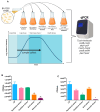Chromosomal Type II Toxin-Antitoxin Systems May Enhance Bacterial Fitness of a Hybrid Pathogenic Escherichia coli Strain Under Stress Conditions
- PMID: 39591224
- PMCID: PMC11598369
- DOI: 10.3390/toxins16110469
Chromosomal Type II Toxin-Antitoxin Systems May Enhance Bacterial Fitness of a Hybrid Pathogenic Escherichia coli Strain Under Stress Conditions
Abstract
The functions of bacterial plasmid-encoded toxin-antitoxin (TA) systems are unambiguous in the sense of controlling cells that fail to inherit a plasmid copy. However, its role in chromosomal copies is contradictory, including stress-response-promoting fitness and antibiotic treatment survival. A hybrid pathogenic Escherichia coli strain may have the ability to colonize distinct host niches, facing contrasting stress environments. Herein, we determined the influence of multiple environmental stress factors on the bacterial growth dynamic and expression profile of previously described TA systems present in the chromosome of a hybrid atypical enteropathogenic and extraintestinal E. coli strain. Genomic analysis revealed 26 TA loci and the presence of five type II TA systems in the chromosome. Among the tested stress conditions, osmotic and acid stress significantly altered the growth dynamics of the hybrid strain, enhancing the necessary time to reach the stationary phase. Using qPCR analyses, 80% of the studied TA systems were differentially expressed in at least one of the tested conditions, either in the log or in the stationary phase. These data indicate that type II TA systems may contribute to the physiology of pathogenic hybrid strains, enabling their adaptation to different milieus.
Keywords: gene transcription; hybrid strain; stress conditions; toxin–antitoxin type II.
Conflict of interest statement
The authors declare no conflicts of interest. The funders had no role in the design of the study; in the collection, analyses, or interpretation of data; in the writing of the manuscript; or in the decision to publish the results.
Figures




References
Publication types
MeSH terms
Substances
Grants and funding
LinkOut - more resources
Full Text Sources

